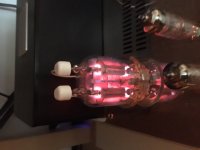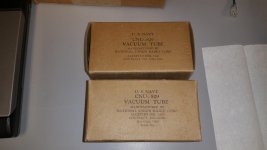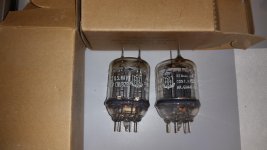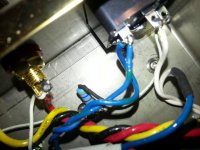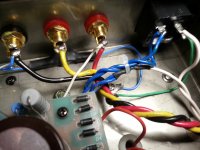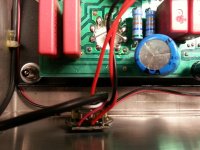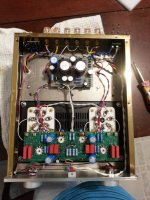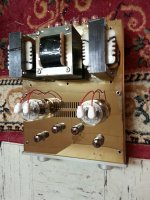Hi
I have some NOS Russian GU29s arrive down under for my Audioromy FU 29. Look what happens when i plug them in! Is this just 'need for biasing' or are they dud. One channel only shown but the other tube does the same. Sever cherry plating too. Looks fantastic, lovely bluey purple glow before the cherry plate red takes over.
This within 20 seconds of turning on the amp - turned off immediately after photo and put old RCA 829B back in. Duff tubes? All advice appreciated.
I have some NOS Russian GU29s arrive down under for my Audioromy FU 29. Look what happens when i plug them in! Is this just 'need for biasing' or are they dud. One channel only shown but the other tube does the same. Sever cherry plating too. Looks fantastic, lovely bluey purple glow before the cherry plate red takes over.
This within 20 seconds of turning on the amp - turned off immediately after photo and put old RCA 829B back in. Duff tubes? All advice appreciated.
Attachments
Looks like they have agida. Gas/heartburn. When the color is deep inside of the elements, as this is, they usually can't be saved.
Last edited:
Back in the 60's when we got a transmitting valve that was like that, the cause was gas in the vacuum and we knew them as 'soft'. If the bias is OK (test with a known good GU29), replace it.
Try increasing the -ve bias voltage if it is red plating.
Try increasing the -ve bias voltage if it is red plating.
Thanks all. Both tubes fluoresce like that. I will have a go at biasing at the weekend and see if I can limit the glow. If not , it's the bin! Russian NOS... Any suggestions for a replacement brand / country of origin / not China please! ..
I have a pair of (apparently) NOS National Union US Navy 829b's.
They are in original boxes and are in superb physical condition.
Shoot me a PM, we can work something out.
They are in original boxes and are in superb physical condition.
Shoot me a PM, we can work something out.
I had a new build amp have a valve glow like that.
I had omitted the grid stopper resistor and the tube was passing max current.
Sounds to me like bias problem or just duff tubes.
I had omitted the grid stopper resistor and the tube was passing max current.
Sounds to me like bias problem or just duff tubes.
I have one of these amps which (not surprisingly) I have heavily modified.
When you change tubes you need to rebias and rebalance the output tubes one channel at a time, that said I think these are gassy or worse.
Strange as the Russian GU29 is highly recommended in this amp.
I have a pair of WWII Kenrad 829Bs that I plan to install in mine at some point.
You know that the Chinese FU29 is actually quite decent.
Biggest single improvement was chucking the cheap ALPs pot for an inexpensive Chinese made 22 step stepped attenuator. Next biggest change was replacing the coupling caps.
Note that contrary to rumors flying around and older schematics the current design reverted to a Williamson configuration.
Actually a very decent amplifier for the price, not without some issues. In particular fix the safety ground. Receptacle ground directly to chassis, ground lift circuit (anti-parallel diodes in parallel with 10 ohm resistor) between chassis and audio ground to break ground loops.
When you change tubes you need to rebias and rebalance the output tubes one channel at a time, that said I think these are gassy or worse.
Strange as the Russian GU29 is highly recommended in this amp.
I have a pair of WWII Kenrad 829Bs that I plan to install in mine at some point.
You know that the Chinese FU29 is actually quite decent.
Biggest single improvement was chucking the cheap ALPs pot for an inexpensive Chinese made 22 step stepped attenuator. Next biggest change was replacing the coupling caps.
Note that contrary to rumors flying around and older schematics the current design reverted to a Williamson configuration.
Actually a very decent amplifier for the price, not without some issues. In particular fix the safety ground. Receptacle ground directly to chassis, ground lift circuit (anti-parallel diodes in parallel with 10 ohm resistor) between chassis and audio ground to break ground loops.
Enrich - thanks - i will PM you tonight
kevinkr - yes i agree - for a cheap amor it sounds great and plenty of gain for my set up. Quick question.. I have made some mods, the coupling caps which was easy, a few more resistors between cathode and ground so i get set the bias current correctly based on voltage drop and maths.
'In particular fix the safety ground.' --> i have found the ground lift circuit - what do I do to make it safe..? just bypass the ground lift to ground..? please explain.
Also - i have hum on both channels - not a huge amount, but noticeable - any ideas? this was the reason for the new GU29s.. I have new 6N1 and 6N3's in..
kevinkr - yes i agree - for a cheap amor it sounds great and plenty of gain for my set up. Quick question.. I have made some mods, the coupling caps which was easy, a few more resistors between cathode and ground so i get set the bias current correctly based on voltage drop and maths.
'In particular fix the safety ground.' --> i have found the ground lift circuit - what do I do to make it safe..? just bypass the ground lift to ground..? please explain.
Also - i have hum on both channels - not a huge amount, but noticeable - any ideas? this was the reason for the new GU29s.. I have new 6N1 and 6N3's in..
@ nigelwright7557 - hmm, i see how omitting the grid stopper would do that - BUT the original tubes don't fluoresce - lets hope they are not crook - they took ages to get here from Russia - ordered in June, arrived last week!
I guess my first response was just glanced over. So let me be somewhat less succinct. Your NOS (let's make that NVOS - new very old stock) Russian tubes are extremely gassy. So much so that no amount of running or baking is going to recombine the gas. If there were only a faint purple haze on the outside of the elements, between the plate structure and the glass, you might have a chance of burning it off with use. But with a bright vivid color inside the plate, that tube is toast. It has nothing to do with oscillation, dirty pins or biasing.BUT the original tubes don't fluoresce - lets hope they are not crook - they took ages to get here from Russia - ordered in June, arrived last week!
How do I know this? For many years I bought, tested, processed and resold industrial tubes for profit. Very many of them were big and expensive types. And some of them would become gassy to one degree or another. This happens because the glass to metal seals very slowly leak over time for one reason or another. Consequently much time and effort was spent in procedures to degas the costly and worthwhile tubes using various methods like controlled heating/red plating with heavy forced air cooling, long hours of burn-in time and even pulsed AC operation. Eventually it was realized that there was a point of contamination that was beyond correcting.
This gas infiltration of seals happens to all makes of tubes. Even the great Eimac had it's problems with the use of green vaseline uranium glass in it's bases. Ninety percent of green based Eimac tubes will go up in smoke (internally) when the filament is powered up. That's how bad they leaked.
Your GU29's were never tested, and that's giving your seller the benefit of the doubt. It only takes about 100 volts to ionize gas like that. A potential even an el-cheapo tube tester should provide. So what's your options? Return to the seller? Probably not since they're on the opposite side of the world. Complain to them...definitely. Then maybe try for some NOS RCA 829B's or even 3E29's which are the same tube but better rated for RF.
'In particular fix the safety ground.' --> i have found the ground lift circuit - what do I do to make it safe..? just bypass the ground lift to ground..? please explain.
Also - i have hum on both channels - not a huge amount, but noticeable - any ideas? this was the reason for the new GU29s.. I have new 6N1 and 6N3's in..
A couple of comments, can you post some internal pictures of your amp? Mine uses 2C51/5670s (Equivalent to 6N3P) in all positions, and I am wondering if yours is somewhat older than mine - seeing the PCB would help me to identify which you have.
I've attached two pictures of my amp, one as stock and one with safety ground directly to chassis and a ground life between the chassis and the point where the amp was originally grounded to the chassis which was the right channel speaker ground - which goes straight back to a ground on the PSU board. (It was convenient.)
Technically to do it right the safety ground should be bolted directly to the chassis with its own dedicated nut and bolt. Anything however is safer than what they did on mine. Note that I also cleaned up the AC wiring done as a result of a dealer conversion to 120V operation before I got it.
Mine is completely silent, there isn't even a significant level of hiss.
Attachments
I mentioned changing out the pot for an inexpensive stepped attenuator.. Something like this fits and is a BIG improvement over the pot for stupid money: Dact Type 21 Stepped Attenuator Volume Control Hi Fi Grade for Amp Preamp | eBay
I attached a picture of the new control installed, drops in and is fully compatible with the knob as well.
I've also attached a picture of the unmodified amplifier so you can compare with yours, if it looks just like this one you should have 5670/2C51/6N3 in all 4 sockets. There were earlier versions that used the 6N1/6N3 combination so it's hard to say. Mine is a Williamson which was a surprise given the writings about this version on the internet - clearly out of date. (Note the condition of some of the parts in my amp - they were all replaced subsequent to this picture with better components.)
The amplifier sounds surprisingly OK despite the obviously coarse laminations used in the output transformers. I suspect restacking the core with better quality lams would not hurt if you just happened to be able to your hands on something better. The manufacturer claims these lams are sourced from Japan. (I have a Chinese friend who graciously translated the manual that came with mine.)
Just my opinion, but I thought out of the box that this amp sounded a bit better than most stock style Dyna ST-70s I've heard, and with a little work significant improvements were made. It is claimed to make 28Wrms per channel, no signs of clipping at 20W where I ran out of load resistor.. lol I have not measured frequency response or distortion, my impression is bass is well controlled but not overly abundant. I paid a little over $300 for mine which was slightly used and already here in the U.S., I think fair value for the price, noting the grounding issue I mentioned which as delivered is IMHO unsafe and must be fixed before use..
I attached a picture of the new control installed, drops in and is fully compatible with the knob as well.
I've also attached a picture of the unmodified amplifier so you can compare with yours, if it looks just like this one you should have 5670/2C51/6N3 in all 4 sockets. There were earlier versions that used the 6N1/6N3 combination so it's hard to say. Mine is a Williamson which was a surprise given the writings about this version on the internet - clearly out of date. (Note the condition of some of the parts in my amp - they were all replaced subsequent to this picture with better components.)
The amplifier sounds surprisingly OK despite the obviously coarse laminations used in the output transformers. I suspect restacking the core with better quality lams would not hurt if you just happened to be able to your hands on something better. The manufacturer claims these lams are sourced from Japan. (I have a Chinese friend who graciously translated the manual that came with mine.)
Just my opinion, but I thought out of the box that this amp sounded a bit better than most stock style Dyna ST-70s I've heard, and with a little work significant improvements were made. It is claimed to make 28Wrms per channel, no signs of clipping at 20W where I ran out of load resistor.. lol I have not measured frequency response or distortion, my impression is bass is well controlled but not overly abundant. I paid a little over $300 for mine which was slightly used and already here in the U.S., I think fair value for the price, noting the grounding issue I mentioned which as delivered is IMHO unsafe and must be fixed before use..
Attachments
i lowered the G2 to something like 180 volts and then used cathode resistor bias in the output to get rid of red plating.....no perceived change is the sound after the change...
Hi all, thanks for all the responses -
@HollowState - yep, the GU 29s are fried, gas inclusion for sure - they will become a xmas tree ornimante
@kevinkr - i think mine must be older - i have a red PCB and a slightly different layout - i will post some pics tomorrow - thanks for the instructions on the earth grounding - also, what resistance range does the pot you bought from eBay have? i see they list 6 - does it matter..? i will do this upgrade next. FYI i paid A$500 for mine from eBay Australia - about $350 US - so great value
@Eniric - looking forward to the new valves! thanks for pics
@stocktrader200 - it sounds great. A great upgrade form my Musical Fidelity B200. Spacious sound stage, fantastic midrange - especially female vocals. Tracy Chapman fast car is mesmerising , likewise everything but the girl unplugged or more recently Sam Watson Faberge Egg Shaker. All so good - listening to it now. I listen thru bi-wired Quad 12Ls (great monitor if you can find a pair) and use the rear wall as my bass tone control (involves moving the speakers - but hey). I think the Quads are 6 ohms nominal load but i always get to loud enough. In fact, this amp flatters a good recording and embarrasses a poor recording. Even spotify through an iPhone sounds good - but the Rega Planer 3 with high quality recordings sound the best. I'm going to experiment with high quality 24 bit recordings - this amp loves detail so lets see what it can do with a great source..
@HollowState - yep, the GU 29s are fried, gas inclusion for sure - they will become a xmas tree ornimante
@kevinkr - i think mine must be older - i have a red PCB and a slightly different layout - i will post some pics tomorrow - thanks for the instructions on the earth grounding - also, what resistance range does the pot you bought from eBay have? i see they list 6 - does it matter..? i will do this upgrade next. FYI i paid A$500 for mine from eBay Australia - about $350 US - so great value
@Eniric - looking forward to the new valves! thanks for pics
@stocktrader200 - it sounds great. A great upgrade form my Musical Fidelity B200. Spacious sound stage, fantastic midrange - especially female vocals. Tracy Chapman fast car is mesmerising , likewise everything but the girl unplugged or more recently Sam Watson Faberge Egg Shaker. All so good - listening to it now. I listen thru bi-wired Quad 12Ls (great monitor if you can find a pair) and use the rear wall as my bass tone control (involves moving the speakers - but hey). I think the Quads are 6 ohms nominal load but i always get to loud enough. In fact, this amp flatters a good recording and embarrasses a poor recording. Even spotify through an iPhone sounds good - but the Rega Planer 3 with high quality recordings sound the best. I'm going to experiment with high quality 24 bit recordings - this amp loves detail so lets see what it can do with a great source..
I replaced the pot with a 100K attenuator in order to maintain the relatively high input impedance for some of my tube tuners and tube phono stages. I would probably stick with that value, otherwise 50K might be reasonable for use with all solid state sources.
Yes it sounds like you have one of the older versions. There were Williamson and none Williamson versions in the past, even older ones do not have the staggered sockets on the driver board.
Working on the driver board is somewhat complicated by the fact that it is soldered to and depends on the 4 sockets for support. The socket hardware is not accessible once the board is place.
Yes it sounds like you have one of the older versions. There were Williamson and none Williamson versions in the past, even older ones do not have the staggered sockets on the driver board.
Working on the driver board is somewhat complicated by the fact that it is soldered to and depends on the 4 sockets for support. The socket hardware is not accessible once the board is place.
- Status
- Not open for further replies.
- Home
- Amplifiers
- Tubes / Valves
- Fluorescing GU 29 tubes - whats wrong?

